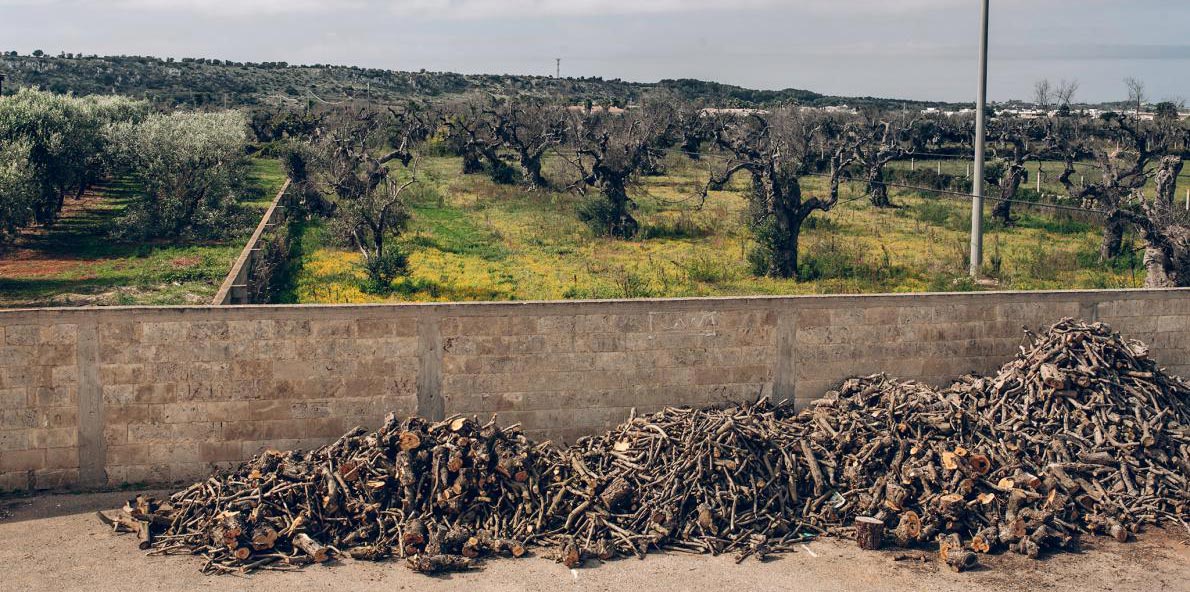Scientists Race to Save Italy's Dying Olive Trees

"The Salento region, in Italy's boot heel, is widely known for its olive oil. But its storied groves face an uncertain future. In 2013, a devastating plant bacterium called Xylella fastidiosa was introduced to the region. To prevent the bacterium from spreading farther, officials made farmers uproot and burn infected trees.
At first, it wasn’t clear what was causing the decline. Was it a fungus? A virus? Something else entirely? Scientists showed up in the olive groves to sample the trees, urgently trying to find the cause.
Scientists and growers are trying to find olive cultivars resistant to the devastating Xylella so they can replace the dead and dying trees. They've found a few promising options, but they need to see whether the oil made from the new cultivars tastes good."
With some of the highest quality, most world-renown extra virgin olive oils coming solely from the Salento region of Puglia, Italy, the scientific community and culinary world should have concerns about the spread of olive tree-killing bacterium in the area. Xylella bacteria strains, famous in the Americas for completely destroying vineyards of both California and Brazil, are one of the most deadly on earth, causing affected vines, bushes and trees to slowly dry, wither and die of thirst. Despite grove owners using homemade remedies to slow death and get many more years of olives from their trees, no cure for the bacterial infection exists. Most studies show that once a plant is infected it stays that way until the end of its life.
Pestilent spittlebugs native to Italy are the vessels by which this deadly disease is spread from tree to tree. These microscopic insects suck water directly from the plant's xylem and can carry Xylella bacteria as they move from one tree to another. Half of Salento has already been declared infected, and some farmers estimate it will take many decades for their EVOO productions to fully recover from the damage already done. If the bacterium isn't removed then the disease will spread and olive trees from the region might become extinct.
Baffled by how Xylella got to Europe in the first place, the EU and the Italian government stopped certain exports from leaving the Salento region and urged Italian growers in the area to uproot and burn their trees. Being financially and emotionally attached to the groves they harvest, many farmers were against the killing of their ancient olive trees. With an ongoing debate on how to eradicate Xylella and farmers reluctant to destroy infected trees, too many years have gone by without enough being done to stop the spread of the bacterium. As the the sickness moves northward up the "heel" of the Italian "boot", other olive groves of different species in different areas of the country are more likely to become infected as well.
 Italy and Spain are easily the biggest producers of virgin olive oil in the world. If the infection is not contained and other countries like Spain, France and Greece aren't prepared to act at the first sign of contamination, the spread of this illness could completely ravage the supply of the world's olive oil. Xylella carrying spittlebugs can migrate to new regions and even be brought to other nations on trade ships, a fact which has caused the recent ban on Puglian imports in some countries. Even though this blight-like sickness is only affecting trees one part of one country today, the EVOO industry is not far away from a real catastrophe.
Italy and Spain are easily the biggest producers of virgin olive oil in the world. If the infection is not contained and other countries like Spain, France and Greece aren't prepared to act at the first sign of contamination, the spread of this illness could completely ravage the supply of the world's olive oil. Xylella carrying spittlebugs can migrate to new regions and even be brought to other nations on trade ships, a fact which has caused the recent ban on Puglian imports in some countries. Even though this blight-like sickness is only affecting trees one part of one country today, the EVOO industry is not far away from a real catastrophe.
As uncertainty looms in the air, scientists and farmers are looking to the future, combating the migration of spittlebug populations within Italy while pushing for cultivation of olive tree species resistant to Xylella. So far only two types of olive trees resistant to the bacteria have been discovered. The farmers who are replacing their infected trees with Xylella-resistant ones are doing so out of desperation. Some growers, who have been making the same oil from the same olives for generations, must now switch to a different species and embrace different tasting virgin oil in order to avoid going out of business.
Certain Italian producers supply the world with some of the truest quality extra virgin olive oil on the market. If Xylella contaminated olive trees and other plant life aren't removed from Italian soil, we might see some of our favorite EVOO brands begin to disappear off store shelves. It might be painful for farmers to kill the trees that have provided their families with a means for life over hundreds of years, but at this point there seems to be no other option. The fate of the olive oil industry depends on the removal of this disease and the cultivating of resistant species in affected areas, even if that means growing an olive with a different flavor.
For more information about the issue where farmers discuss their perspective and methods used to combat the bacteria, as well as the science behind there being no cure and how the EU and Italy have declared the area infected, please read these articles: Italy's Farmers turn to Cow Dung to Save Beloved Olive Trees | Where the Olive Trees are Dying: A Front-Line Report on Xylella
Sources: National Geographic



 (888) 268-8780
(888) 268-8780

